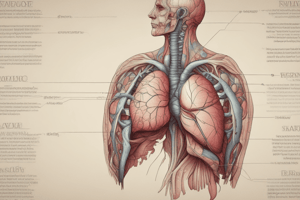Podcast
Questions and Answers
Which ligament separates the right and left lobes of the liver?
Which ligament separates the right and left lobes of the liver?
- Falciform ligament (correct)
- Hepatogastric ligament
- Coronary ligament
- Gastrophrenic ligament
What is the main function of the hepatic portal vein?
What is the main function of the hepatic portal vein?
- Carries nutrient-rich blood from the digestive system (correct)
- Supplies oxygenated blood to the liver
- Regulates blood clotting
- Stores glycogen
What is the liver's role in metabolism?
What is the liver's role in metabolism?
- Only produces bile
- Only stores glycogen
- Regulates carbohydrate, protein, and fat metabolism (correct)
- Only breaks down ammonia into urea
What is the function of the liver's bile production?
What is the function of the liver's bile production?
Which of the following is NOT a surface feature of the liver?
Which of the following is NOT a surface feature of the liver?
What is the liver's role in detoxification?
What is the liver's role in detoxification?
Flashcards are hidden until you start studying
Study Notes
Anatomy
- Location: Right upper quadrant of the abdominal cavity, beneath the diaphragm
- Shape: Irregular, wedge-shaped organ
- Divided into:
- Lobes: Right and left lobes, separated by the falciform ligament
- Segments: 8 functional segments, each with its own blood supply and bile drainage
- Surface features:
- Anterior surface: Covered by the peritoneum, attached to the diaphragm by the coronary ligament
- Posterior surface: In contact with the right kidney, adrenal gland, and inferior vena cava
- Blood supply:
- Hepatic artery: Branch of the celiac artery, supplies oxygenated blood
- Hepatic portal vein: Carries nutrient-rich blood from the digestive system
- Bile drainage:
- Bile ducts: Merge to form the common hepatic duct, which joins the cystic duct to form the common bile duct
Functions
- Detoxification: Removes toxins and waste products from the blood
- Breaks down ammonia into urea
- Converts bilirubin into bile
- Metabolism: Regulates carbohydrate, protein, and fat metabolism
- Stores glycogen and releases glucose into the bloodstream
- Converts amino acids into urea and other nitrogen-containing compounds
- Production: Produces various substances, including:
- Bile: Aids in fat digestion and absorption
- Cholesterol: Essential for cell membrane structure and function
- Proteins: Albumin, clotting factors, and lipoproteins
- Vitamins: Vitamin D, vitamin K, and other fat-soluble vitamins
- Storage: Stores vitamins, minerals, and glycogen
- Immune function: Participates in the immune response by removing pathogens and toxins from the blood
- Regulation: Regulates blood clotting, hormone production, and blood sugar levels
Studying That Suits You
Use AI to generate personalized quizzes and flashcards to suit your learning preferences.



